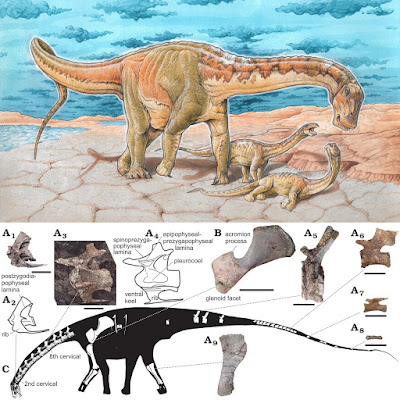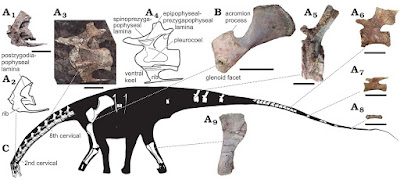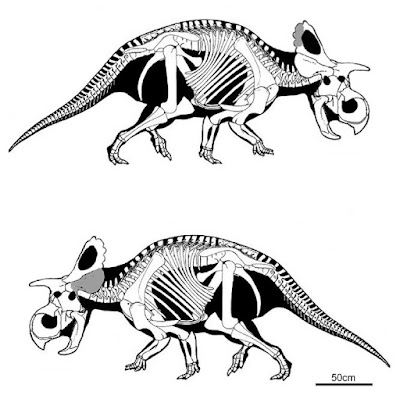[Most Recent Entries] [Calendar View]
Sunday, November 4th, 2018
| Time | Event | ||||
| 1:46p | [Paleontology • 2018] Lavocatisaurus agrioensis • A New Rebbachisaurid Sauropod from the Aptian–Albian, Lower Cretaceous Rayoso Formation, Neuquén, Argentina
Rebbachisaurids are a group of basal diplodocimorph sauropods that diversified in Gondwana at the end of the Early Cretaceous and the beginning of the Late Cretaceous. It is a group of great palaeobiogeographical interest, for it clearly illustrates various processes of dispersal throughout Gondwana and to Laurasia prior to the breakup of Africa and South America. However, the relationships within the group are still under discussion owing to the scarcity of cranial material that would help clarify them. In the present paper we describe the new rebbachisaurid Lavocatisaurus agrioensis gen. et sp. nov. from the Aptian–Albian (Lower Cretaceous) of Neuquén (Argentina). Remains have been recovered belonging to an adult specimen (holotype) and two immature specimens (paratypes). Taken together, almost all the bones of the taxon are represented, including most of the cranium. Lavocatisaurus agrioensis gen. et sp. nov. is the first rebbachisaurid from Argentina with an almost complete cranium, making it possible to recognize differences with respect to other rebbachisaurids, such as the highly derived Nigersaurus. Among its most notable characters are the presences of a large preantorbital fenestra and maxillary teeth that are significantly larger than those of the dentary. Our phylogenetic study places Lavocatisaurus amongst basal rebbachisaurids, as the sister lineage to Khebbashia (the clade formed by Limaysaurinae + Rebbachisaurinae). This position, which is somewhat more derived than that previously suggested for Comahuesaurus and Zapalasaurus (the Argentinean rebbachisaurids closest in geographical and geological terms), reaffirms the presence of different basal rebbachisaurid lineages in the Early Cretaceous of Patagonia. Key words: Dinosauria, Rebbachisauridae, phylogeny, Cretaceous, Rayoso Formation, Argentina. Saurischia Seeley, 1887 Sauropoda Marsh, 1878 Diplodocoidea Marsh, 1878 sensu Upchurch, 1995 Diplodocimorpha Calvo and Salgado, 1995 Rebbachisauridae Bonaparte, 1997 Genus Lavocatisaurus nov. Etymology: In honour of the French researcher René Lavocat (1909–2007), who described Rebbachisaurus, the first known representative of Rebbachisauridae. Lavocatisaurus agrioensis sp. nov. Etymology: In reference to the locality of Agrio del Medio, from which the new species was found
Conclusions: Lavocatisaurus agrioensis is the first of the South American rebbachisaurids that preserves the rostral region of the cranium, which has allowed us to undertake a reliable enough reconstruction of the skull. The skull has a combination of morphological characters that justifies its definition as a new taxon within Rebbachisauridae along with the less derived rebbachisaurids from the Early Cretaceous of Argentina such as Zapalasaurus and Comahuesaurus. Our phylogenetic study situates Lavocatisaurus as the sister lineage of Khebbashia (Fig. 5). Lavocatisaurus is the most derived basal rebbachisaurid known to date, providing reliable information on the evolutionary steps that occurred just prior to the diversification of Rebbachisaurinae. José I. Canudo, José L. Carballido, Alberto Garrido and Leonardo Salgado. 2018. A New Rebbachisaurid Sauropod from the Aptian–Albian, Lower Cretaceous Rayoso Formation, Neuquén, Argentina. Acta Palaeontologica Polonica. in press. DOI: 10.4202/app.00524.2018 Scientists discover a new species of dinosaur 110 million years old in Argentina | ||||
| 3:20p | [Paleontology • 2018] Crittendenceratops krzyzanowskii • A New Ceratopsid Dinosaur (Centrosaurinae: Nasutoceratopsini) from the Fort Crittenden Formation, Upper Cretaceous (Campanian) of Arizona
A new ceratopsid dinosaur, Crittendenceratops krzyzanowskii, is described from the Fort Crittenden Formation (Upper Cretaceous) of southeastern Arizona, and is based on two individuals consisting of partial cranial material recovered from the same stratigraphic unit. A phylogenetic analysis of ceratopsids recovers Crittendenceratops as a member of Nasutoceratopsini, a subclade of Centrosaurinae defined as the stem-based clade of centrosaurine ceratopsids more closely related to Avaceratops lammersi and Nasutoceratops titusi than to Centrosaurus apertus. Reconstruction of the parietosquamosal frill based on two specimens indicates that C. krzyzanowskii is a unique, nasutoceratopsin taxon. The parietosquamosal frill of C. krzyzanowskii had a broad medial ramus and at least five epiparietal loci situated around the margin of the frill, a typical characteristic of Centrosaurinae. The epiparietals are pronounced triangles that are dorsally concave and ventrally convex. Additionally, two large, triangular hook-like flanges, nearly the size of the epiparietal loci, are situated along the dorsomedial margin of the parietal ramus. The left squamosal has a pronounced dorsal ridge with a single dorsal squamosal process and large episquamosal undulations, a typical characteristic of Centrosaurinae. The presence of C. krzyzanowskii in Arizona indicates that the nasutoceratopsins persisted into the late Campanian. The temporal and paleobiogeographic distribution of Nasutoceratopsini further weakens the hypothesis of distinct northern and southern Laramidian provinces. SYSTEMATIC PALEONTOLOGY ORNITHISCHIA Seeley, 1888 CERATOPSIA Marsh, 1890 NEOCERATOPSIA Sereno, 1986 CERATOPSIDAE Marsh, 1888 CENTROSAURINAE Lambe, 1915 NASUTOCERATOPSINI Ryan, Holmes, Mallon, Loewen, and Evans, 2017 Crittendenceratops, new genus Etymology: Derived from “Crittenden” referring to the Fort Crittenden Formation, the stratum from which the specimen came; “ceratops,” meaning a “horned-face” in Latinized Greek. Crittendenceratops krzyzanowskii, new species Etymology: The specific epithet honors the late Stan Krzyzanowski, who discovered and collected the specimen. Diagnosis: Centrosaurine ceratopsid characterized by the following unique combination of characters: forward-curving, hook-like flanges located along the dorsomedial margin of the parietal lateroposterior ramus; extensive epiparietals located along the lateroposterior margin of the parietal ramus; parietal ramus dorsoventrally thick; dorsal surface of the parietal ramus contains deep elongate fossa; posteroventrolateral concavity pronounced and extensively rugose; squamosal dorsal ridge short, pronounced and located in close proximity to dorsolateral margin of the bone. .... CONCLUSIONS: Crittendenceratops krzyzanowskii is a new genus and species that represents the youngest current record of nasutoceratopsins in North America. The identity of a new member of the Nasutoceratopsini clade in southern Laramidia fills in the evolutionary gap between the slightly older Yehuecauhceratops and the nasutoceratopsins known from the late Campanian in northwestern North America. Furthermore, Crittendenceratops and Yehuecauhceratops add new information to the paleobiogeographic distribution of nasutoceratopsins during the Cretaceous.
Sebastian G. Dalman, John-Paul M. Hodnett, Asher J. Lichtig and Spencer G. Lucas. 2018. A New Ceratopsid Dinosaur (Centrosaurinae: Nasutoceratopsini) from the Fort Crittenden Formation, Upper Cretaceous (Campanian) of Arizona. New Mexico Museum of Natural History and Science Bulletin. 79: 141–164. |
| << Previous Day |
2018/11/04 [Calendar] |
Next Day >> |










